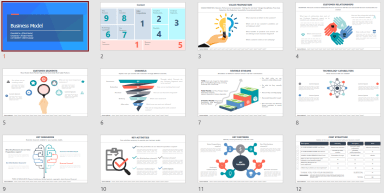
Originally published: 12/02/2024 09:22
Last version published: 13/02/2024 11:09
Publication number: ELQ-16680-2
View all versions & Certificate
Last version published: 13/02/2024 11:09
Publication number: ELQ-16680-2
View all versions & Certificate

Business Model Development Templates
12 Powerpoint Templates to perform standardized research and create Business Model reports.
Description
FRAMEWORK QUESTIONS❓VALUE PROPOSITION
What value do we deliver to the customer? Which one of our customer’s problems are we helping to solve? What bundles of products and services are we offering to each Customer Segment? Which customer needs are we satisfying?
CHARACTERISTICS
Newness Performance Customization “Getting the Job Done” Design Brand/Status Price Cost Reduction Risk Reduction Accessibility Convenience/Usability
CUSTOMER RELATIONSHIPS
What type of relationship does each of our Customer Segments expect us to establish and maintain with them? Which ones have we established? How are they integrated with the rest of our business model? How costly are they?
EXAMPLES
Personal assistance Dedicated Personal Assistance Self-Service Automated Services Communities Co-creation
CUSTOMER SEGMENTS
For whom are we creating value? Who are our most important customers?
Mass Market Niche Market Segmented Diversified Multi-sided Platform
CHANNELS
Through which Channels do our Customer Segments want to be reached? How are we reaching them now? How are our Channels integrated? Which ones work best? Which ones are most cost-efficient? How are we integrating them with customer routines?
CHANNEL PHASES
For what value are our customers really willing to pay? For what do they currently pay? How are they currently paying? How would they prefer to pay? How much does each Revenue Stream contribute to overall revenues?
TYPES:
Asset sale, Usage fee, Subscription Fees, Lending/Renting/Leasing, Licensing, Brokerage fees, Advertising FIXED PRICING: List Price, Product feature dependent, Customer segment dependent, Volume dependent DYNAMIC
PRICING: Negotiation (bargaining), Yield Management, Real-time-Market
TECHNOLOGY CAPABILITIES
What technical skills are needed?
KEY RESOURCES
What Key Resources do our Value Propositions require? Our Distribution Channels? Customer Relationships? Revenue Streams?
TYPES OF RESOURCES
Physical Intellectual (brand patents, copyrights, data) Human Financial
KEY ACTIVITIES
What Key Activities do our Value Propositions require? Our Distributions channels? Customer relationships? Revenue streams?
CATEGORIES
Production Problem Solving Platform/Network
KEY PARTNERS
What Key Activities do our Value Propositions require? Our Distributions channels? Customer relationships? Revenue streams?
CATEGORIES
Production Problem Solving Platform/Network
COST STRUCTURE
What are the most important costs inherent in our business model? Which Key Resources are most expensive? Which Key Activities are most expensive?
IS YOUR BUSINESS MORE
Cost Driven (leanest cost structure, low price value proposition, maximum automation, extensive outsourcing) Value Driven (focused on value creation, premium value proposition)
SAMPLE CHARACTERISTICS
Fixed Costs (salaries, rents, utilities), Variable costs, Economies of scale, Economies of scope
FRAMEWORK QUESTIONS❓VALUE PROPOSITION
What value do we deliver to the customer? Which one of our customer’s problems are we helping to solve? What bundles of products and services are we offering to each Customer Segment? Which customer needs are we satisfying?
CHARACTERISTICS
Newness Performance Customization “Getting the Job Done” Design Brand/Status Price Cost Reduction Risk Reduction Accessibility Convenience/Usability
CUSTOMER RELATIONSHIPS
What type of relationship does each of our Customer Segments expect us to establish and maintain with them? Which ones have we established? How are they integrated with the rest of our business model? How costly are they?
EXAMPLES
Personal assistance Dedicated Personal Assistance Self-Service Automated Services Communities Co-creation
CUSTOMER SEGMENTS
For whom are we creating value? Who are our most important customers?
Mass Market Niche Market Segmented Diversified Multi-sided Platform
CHANNELS
Through which Channels do our Customer Segments want to be reached? How are we reaching them now? How are our Channels integrated? Which ones work best? Which ones are most cost-efficient? How are we integrating them with customer routines?
CHANNEL PHASES
- Awareness
- Evaluation
- Purchase
- Delivery
- After sales
For what value are our customers really willing to pay? For what do they currently pay? How are they currently paying? How would they prefer to pay? How much does each Revenue Stream contribute to overall revenues?
TYPES:
Asset sale, Usage fee, Subscription Fees, Lending/Renting/Leasing, Licensing, Brokerage fees, Advertising FIXED PRICING: List Price, Product feature dependent, Customer segment dependent, Volume dependent DYNAMIC
PRICING: Negotiation (bargaining), Yield Management, Real-time-Market
TECHNOLOGY CAPABILITIES
What technical skills are needed?
KEY RESOURCES
What Key Resources do our Value Propositions require? Our Distribution Channels? Customer Relationships? Revenue Streams?
TYPES OF RESOURCES
Physical Intellectual (brand patents, copyrights, data) Human Financial
KEY ACTIVITIES
What Key Activities do our Value Propositions require? Our Distributions channels? Customer relationships? Revenue streams?
CATEGORIES
Production Problem Solving Platform/Network
KEY PARTNERS
What Key Activities do our Value Propositions require? Our Distributions channels? Customer relationships? Revenue streams?
CATEGORIES
Production Problem Solving Platform/Network
COST STRUCTURE
What are the most important costs inherent in our business model? Which Key Resources are most expensive? Which Key Activities are most expensive?
IS YOUR BUSINESS MORE
Cost Driven (leanest cost structure, low price value proposition, maximum automation, extensive outsourcing) Value Driven (focused on value creation, premium value proposition)
SAMPLE CHARACTERISTICS
Fixed Costs (salaries, rents, utilities), Variable costs, Economies of scale, Economies of scope
This Best Practice includes
12 Powerpoint Slides













